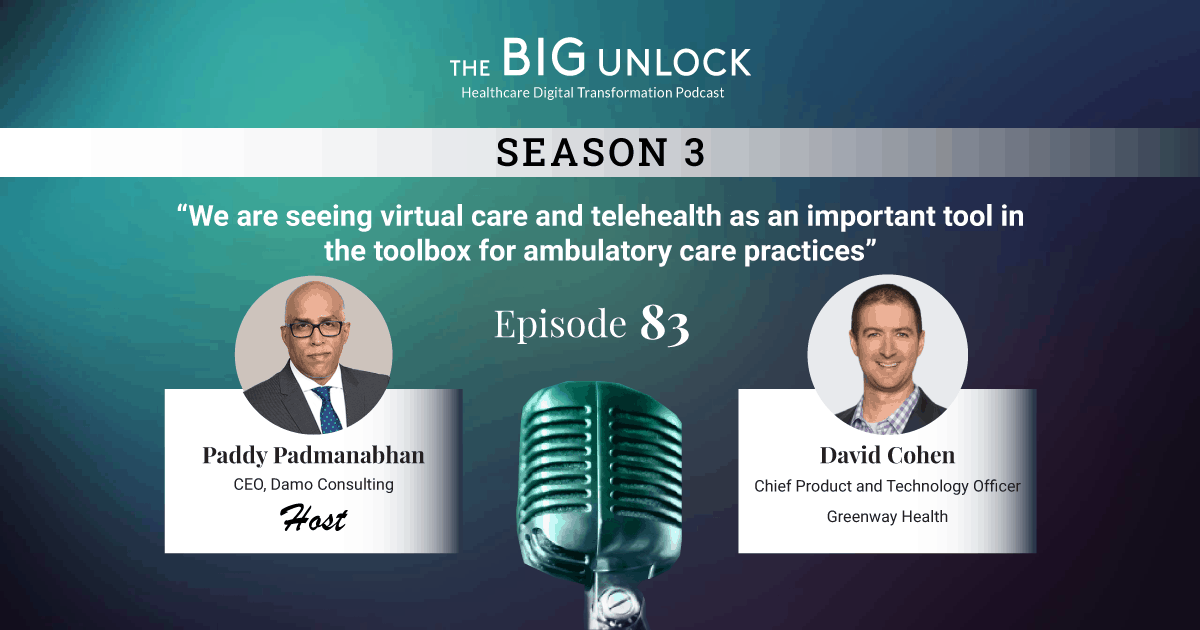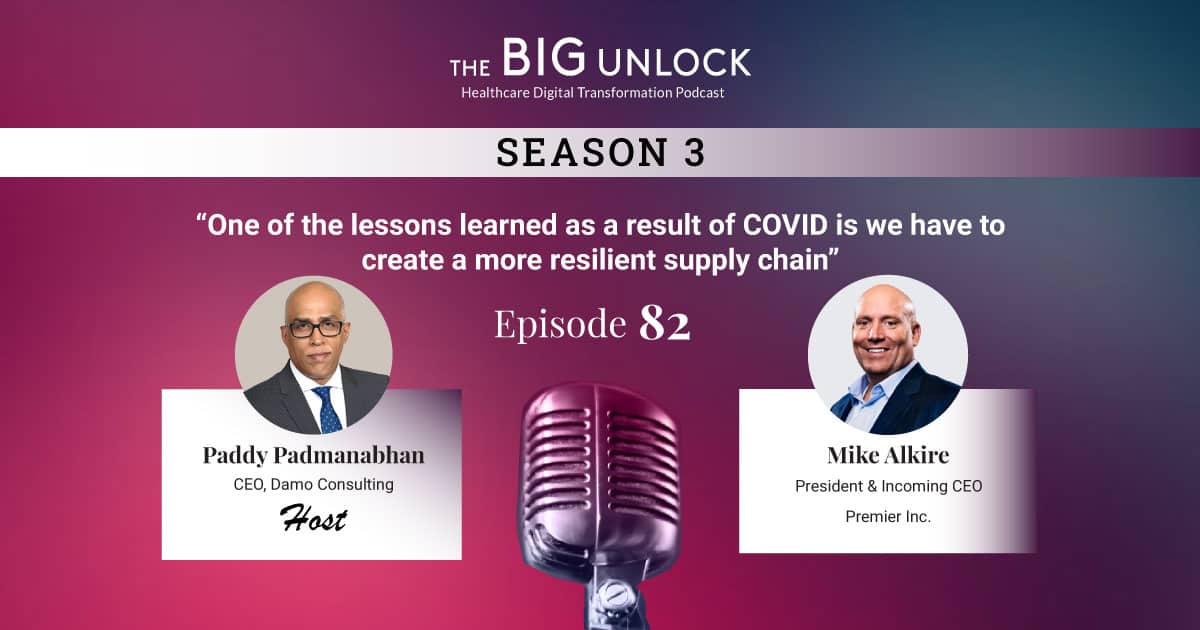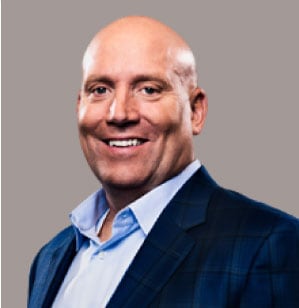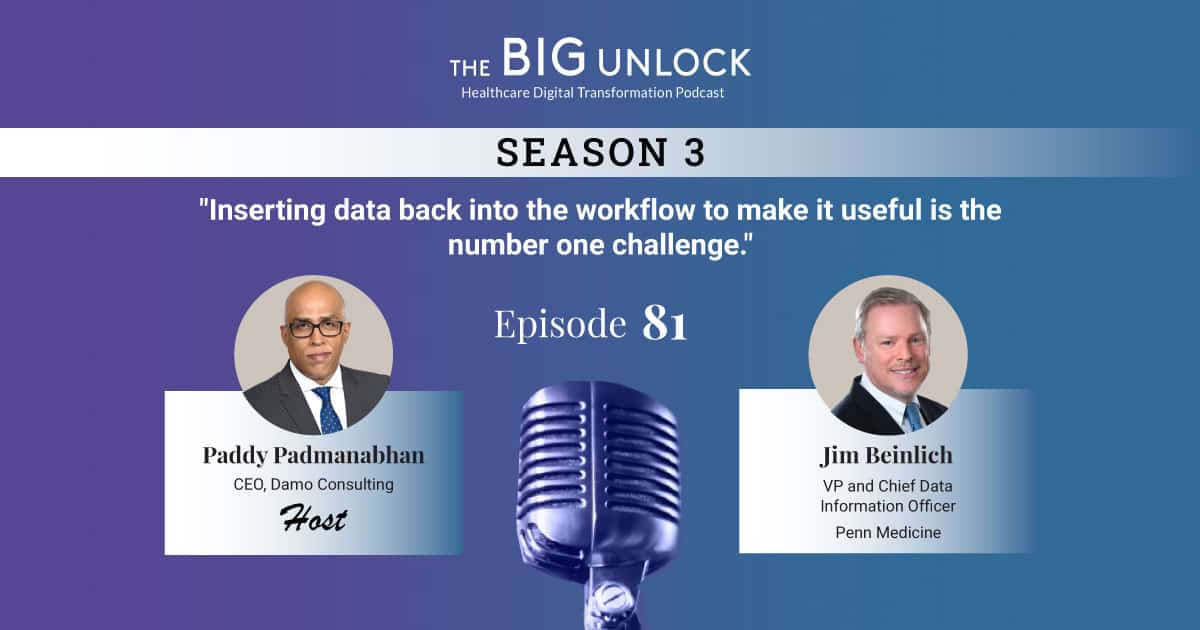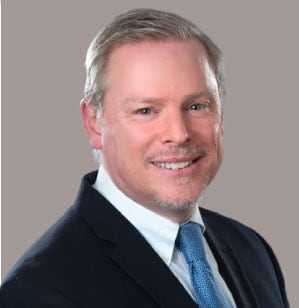Season 3: Episode #83
Podcast with David Cohen, Chief Product and Technology Officer, Greenway Health
"We are seeing virtual care and telehealth as an important tool in the toolbox for ambulatory care practices"
 Hosted by Paddy Padmanabhan
Hosted by Paddy Padmanabhan 
Share
In this episode, David Cohen, Chief Product and Technology Officer of Greenway Health, highlights the need for RCM service providers to scale up to meet the revenue cycle needs of the larger healthcare practices. Greenway Health is an electronic health records (EHR), practice management, and revenue cycle management solutions company serving more than 50,000 ambulatory practices.
The RCM services is witnessing M&A and consolidation to find the efficiencies of scale. David points out that sophisticated RCM software must develop automation capabilities, robust analytics, and machine learning models to help reduce the overall cost of these practices to collect and improve financial outcomes for practices.
David advises medical practices to stay on top of regulatory changes and be aware of the changing payment roles and cycles. Take a listen.
Show Notes |
||||
| 02:50 | The current state of the RCM services provider sector and drivers of M&A and consolidation in the sector. | |||
| 04:48 | The impact of pandemic on Greenway Health’s clients. | |||
| 06:42 | What has the shift to virtual care meant for Greenway Health’s clients in terms of reimbursements and cash flow, specifically telehealth visits? | |||
| 12:32 | There is a highly fragmented market of digital health and telehealth technology providers. What does it mean for practices that are running stand-alone platforms and how should they address it? | |||
| 15:47 | What kind of performance indicators should practices examine in the current context? | |||
| 17:51 | What role do the front-office, clinical, and back-office staff have in RCM, and how can these groups work together efficiently to enable patient care and improve the quality of care? What are the best practices for providers to improve their practice’s RCM? | |||
Q. David, can you tell us a little bit about Greenway Health and your role?
David: I am the chief product and technology officer at Greenway Health, and Greenway is a leading provider of health care technology, solutions, and services. Our clients represent about 50 thousand ambulatory health care providers across multiple specialties, and that equates to about several million patient lives cared for using Greenway solutions. I’ve worked in this intersection of health care and technology for over 15 years, and it’s been a very exciting and dynamic space to be focused on, particularly seeing the level of impact that we’re able to have in helping practices better care for and manage patients and also improving the health of the communities that they serve.
Q. What is the current state of the RCM service provider sector and what is driving M&A and consolidation in the sector?
David: Greenway provides EHR, practice management technology solutions to our clients, and we are a leader in the RCM services space. I agree that there is a lot of M&A activity happening in the market and the major driver for that is really efficiency of scale. So, being part of a larger organization has several advantages. One is sophisticated RCM service providers, like Greenway, develop automation capabilities, robust analytics and machine learning models that can help to reduce the overall cost of practices to collect and improve financial outcomes for practices. And these are capabilities that smaller companies would struggle to develop on their own. It’s also the reason why we’re seeing more and more ambulatory practices turning to revenue cycle services providers to help them with their RCM operations. We also see larger RCM service providers getting better financial outcomes and results for clients, and that can result in better contract negotiations. And the third thing is around scalability.
Q. How has the pandemic impacted your clients, the ambulatory practices?
David: It has been an interesting up and down year and a half for our clients. So COVID, at the early onset had a significant impact on ambulatory practices throughout 2020. We saw spikes in COVID cases and hospitalizations putting immense pressure on healthcare staff and resources, which resulted in steep declines in non-COVID volume and sharply reduced revenues. So, at a macro level, reports show that visits to ambulatory care practices declined by almost 60% last year, with primary care practices experiencing significant revenue losses across the board. In 2021, we are starting to see things stabilized quite a bit, but practices still need to consider adding new revenue cycle resources and added support to improve their financial stability.
Q. There had been a shift to virtual care across the sector, both in the ambulatory and inpatient space and remote patient monitoring, telehealth, telemedicine. All of that has sort of accelerated by an order of magnitude from everything that we see now for your clients, specifically in the ambulatory space. What has this shift meant for your clients in terms of reimbursements and cash flow, specifically telehealth visits?
David: Before COVID, virtual care and telehealth was the most talked-about least adopted technology in the industry. Obviously, there were reimbursement rules that were driving that quite a bit. But COVID was just a tremendous catalyst in the industry that saw significant adoption uptake in telehealth. What we are seeing now is that having virtual care as an additional tool in the toolbox for patient care, it really has a double benefit of keeping patients healthier, as well as helping practices to stabilize financially by giving them an additional source of revenue. The 2021 CMS fee schedule that extended reimbursement guidelines for telehealth visit, it made many of those changes permanent, is exciting for the industry.
A lot of our practices are having glad to see that happen. We believe that telehealth is here to stay. Where it stabilizes is kind of the question now, but it is absolutely important. We are advising practices to start to define and understand how virtual care fits into the services portfolio that they offer, including which visit types will be eligible to schedule virtual care visits as part of that practice strategy. Virtual care is a great way for practices to reach out to underserved areas of their population and they should be thinking about how they can extend the reach of their practice into the communities. Beyond telehealth, we also are seeing increases in opportunities to support remote patient monitoring as part of that overarching virtual care strategy. And it is important for practices in terms of managing patient chronic conditions, particularly when patients are not physically making it into the clinic as frequently with telehealth becoming so accessible and available. So, we are seeing those great improvements to patient outcomes and seeing virtual care telehealth as an important tool in the toolbox for ambulatory care practices, but then also using virtual care telehealth as an important catalyst and additional revenue opportunity for practices.
Q. From your comments, it’s very clear that the providers have to invest in the technology in order to handle virtual visits or provide remote patient monitoring, chronic care management. So, there is a technology enablement aspect to it and a cost related to that as well. How are they dealing with it right now? And does that mean that you are also changing your business model to become something different, something more to your clients than you were earlier?
David: At Greenway, our clients absolutely look for us to stay ahead of the curve in the market. And that is something we really view our role as trusted advisers to our clients and understanding where the industry is going, as well as obviously keeping abreast of the regulatory changes and dynamic regulatory landscape. Last year we saw things start to emerge, Greenway responded by bringing to market a proprietary or home-grown telehealth product. We also extended some of our existing services to offer our clients virtual care and remote patient monitoring capabilities, so certainly I think this industry shift towards virtual care has put Greenway in a position to pivot on behalf of our client, to be able to offer them the services and technologies that our clients need for them to be successful.
Q. We find that there is a highly fragmented market of digital health and telehealth technology providers, and many of these solutions are not well integrated. What does it mean for your clients, the ambulatory practices, that are running stand-alone platforms and how should they address it?
David: At Greenway, one of the things that we will always do is give our clients choice. And our marketplace has several telehealth partners that our clients can leverage. And certainly, we are seeing in the industry a lot of new virtual care players emerging. Greenway went down the path of developing our own telehealth product, because what we saw was that a lot of products on the market were missing the mark with our clients in terms of what they are looking for and the level of integration with their core EHR practice management systems. That lack of integration created a lot of inefficiency in practice workflow. So, we focused on, as we were building a product, things that are important for practices to consider. Number one obviously is being HIPAA compliant and security conscious first and foremost. As many practices were taking a shotgun approach to telehealth adoption, we saw practices out of the gate adopting nonstandard telehealth products. And I would really encourage practices to consider the security aspects of the products that they are leveraging. Number two is the level of integration that practices are expecting from a core product with their existing EHR practice management solutions. And that can come into play in terms of how a telehealth and virtual care product integrates with their scheduling systems, their registration systems, as well as their billing systems, all things that are important in terms of having a seamless practice experience. For example, with our product we have the ability to see virtual waiting room directly within the practice management system. So, it’s one stop shopping for practices and provider. Another integration capability is a real patient flow tracking within the EHR practice management solution. So being able to see when a patient is virtually checked into that waiting room and ready to be seen by a clinician is important. And then when that virtual visit ends up being able to automatically check patients out of the encounter as well, so we know that encounter is closed. There are several areas and points of integration that I think is important for practices to consider as they are adopting different telehealth technologies.
Q. From an ambulatory practice standpoint, what are the new performance indicators that practices examine in the current context? Can you also maybe talk about how you might be enabling them with analytics capabilities in better managing their cash flows and the revenue cycle operations?
David: So, like everything in business if you can’t measure it, you can’t improve it. And that is one of the top mistakes that I think practices make, is trying to run their business blind. So measuring and baselining medical practice financial performance is absolutely the best first step that practices should take in managing their financial health. It also helps to be able to benchmark performance against known best practices. That is something a revenue cycle partner can help with. So, some of the more important revenue cycle, key performance indicators that we focus on with our clients in our Greenway Revenue Services business are things like clean claims rate, days in A/R, percentage of claims over 90 days, collections per visit. We have a series of financial metrics that we track with our clients. It is also important for practice to establish tangible goals for improvement, and that includes setting monthly annual targets. Oftentimes, just by measuring and observing trends of these key metrics, practices can quickly see what’s working and what’s not. So, for example, when we trim days in A/R by aging bucket, it can help to tell a practice how long they’re waiting to collect on balances, and we’ll tell them that their collection strategies are working or not. So, we work directly with our clients to measure those different key performance indicators, baseline them against best practices, establish tangible targets, and then work on improvement plans and strategies against them.
Q. What role do the front-office, clinical, and back-office staff have in RCM, and how can these groups work together efficiently to enable patient care and improve the quality of care? What are the best practices for providers to improve their practice’s RCM?
David: Revenue cycle management absolutely requires shared responsibility among the office staff and team members. They must work together to ensure patient information is complete and accurate from the initial scheduling of an appointment and all the way through clinical documentation. It’s important in any practice that everyone understands the overarching financial objectives of the practice and how their unique function contributes to achieving those goals. So, each function must understand what part they play and how crucial their function is to the overall success of the practice. Once they know that, in identifying the obstacles or blockers to inefficiency becomes much clearer. Having well-defined documentation of these policies and procedures are extremely important for each functional area, as it is defining how the handoffs are going to work across those teams. So, for the front office, for example, over half of claimed denials can be attributed to front-end issues, but most of these denials can be avoided. It is extremely important that the front desk staff is reviewing captured patient information, for example, for accuracy during the patient take process. And that they’re verifying health insurance coverage in any authorizations that may be required prior to service. For clinicians, it’s extremely important that visit documentation is adequately meeting payer documentation requirements. Having clearly defined EHR documentation workflows can help to streamline that process and ensure clinicians are efficient with their time and maximizing the time spent with their patients. In the back-office, staff remains the central point for billing and collections, as well as interfacing with payers to ensure claims are accepted and paid. So, staff should focus on validating accuracy of build procedure and diagnosis codes and ensuring that those codes are correct and valid for data service. Staff should also ensure the effectiveness of their implemented claims scrubber and ensuring high quality play metrics. All the different parts of the practice play an important role in revenue cycle operations and collections and ensuring everyone understands what their role is and what those handoffs need to look like is extremely important for practices.
My top piece of advice for practices to really stay on top of the regulatory changes, stay on top of the changes to payment roles and payment cycles. If there’s one constant in healthcare, it’s changes in practices need to continually stay on top of those changes in the industry, whether that’s things like billing codes or documentation requirement changes, such as the recent easement of documentation that’s necessary for E/M billing coding. That is one of the reasons that Greenway recently launched a new service offering that we’re calling JIRA select, which is a highly customizable revenue cycle offering that’s designed to meet the unique, individualized needs of healthcare practices. And that is something I would encourage practices that are looking for a revenue cycle management partners to really look for that can complement the things they’re already doing and doing well and really identify where they need help and make sure that they’re selecting a partner that can offer them help in the right areas.
About our guest

David is passionate about technology solutions that allow practices to thrive. As Greenway’s Chief Product and Technology Officer, he brings more than 20 years of enterprise information technology leadership experience to the role, with the most recent 15 years focused on healthcare
Prior to joining Greenway, David was responsible for artificial intelligence and machine learning initiatives at Cerner. Before that, he developed custom software solutions and contributed to Agile software development methodologies as a Senior Consultant at ThoughtWorks. Service is core to David’s philosophy. He is committed to serving as a trusted partner to clients and helping them address the healthcare needs of their patients and communities.
Recent Episodes
About the host
Paddy is the co-author of Healthcare Digital Transformation – How Consumerism, Technology and Pandemic are Accelerating the Future (Taylor & Francis, Aug 2020), along with Edward W. Marx. Paddy is also the author of the best-selling book The Big Unlock – Harnessing Data and Growing Digital Health Businesses in a Value-based Care Era (Archway Publishing, 2017). He is the host of the highly subscribed The Big Unlock podcast on digital transformation in healthcare featuring C-level executives from the healthcare and technology sectors. He is widely published and has a by-lined column in CIO Magazine and other respected industry publications.

